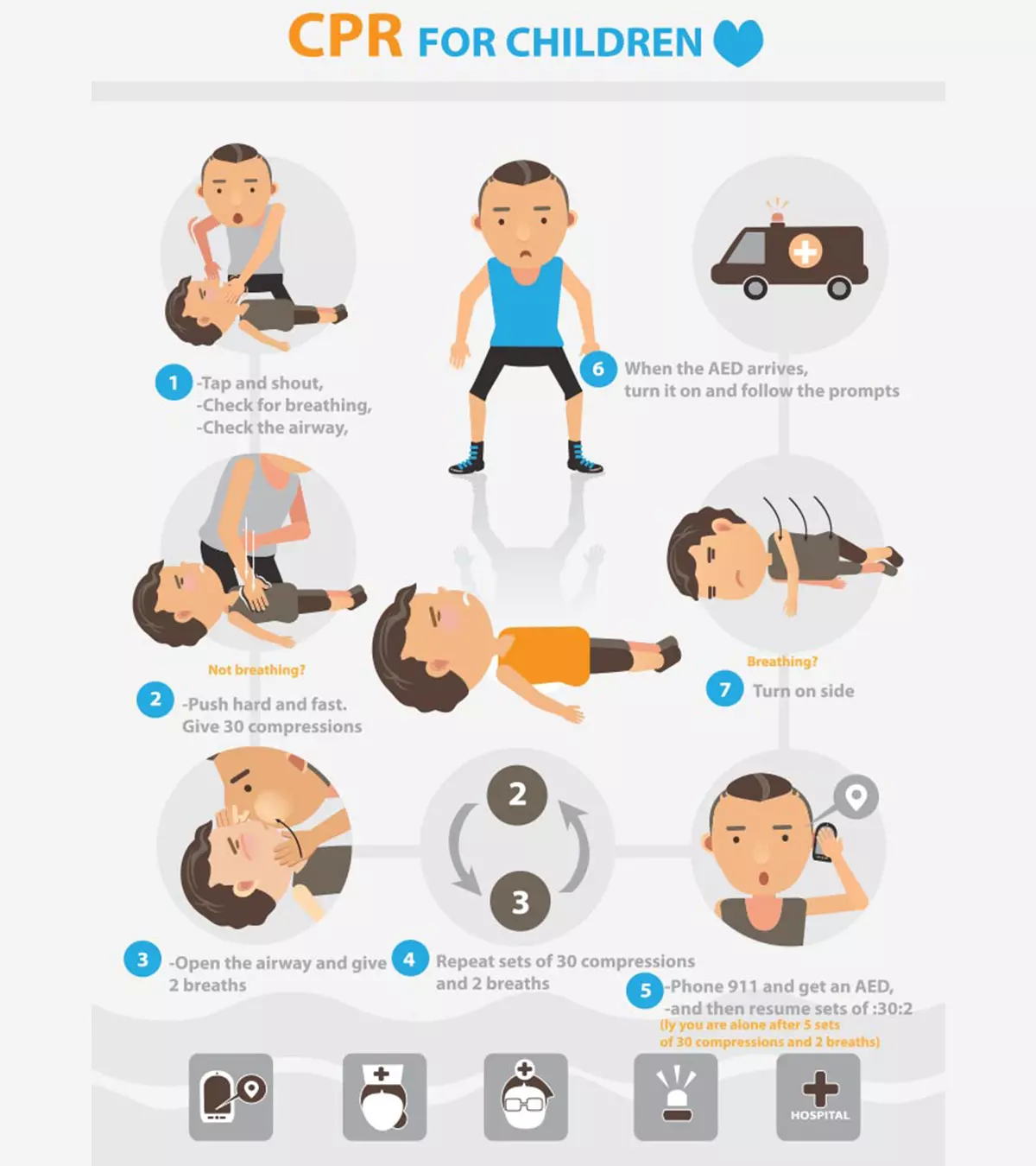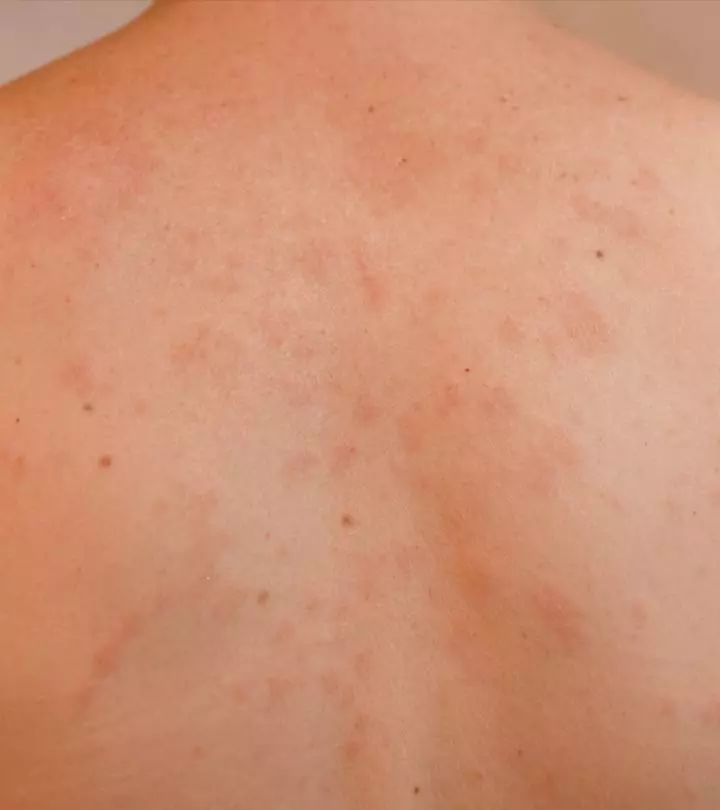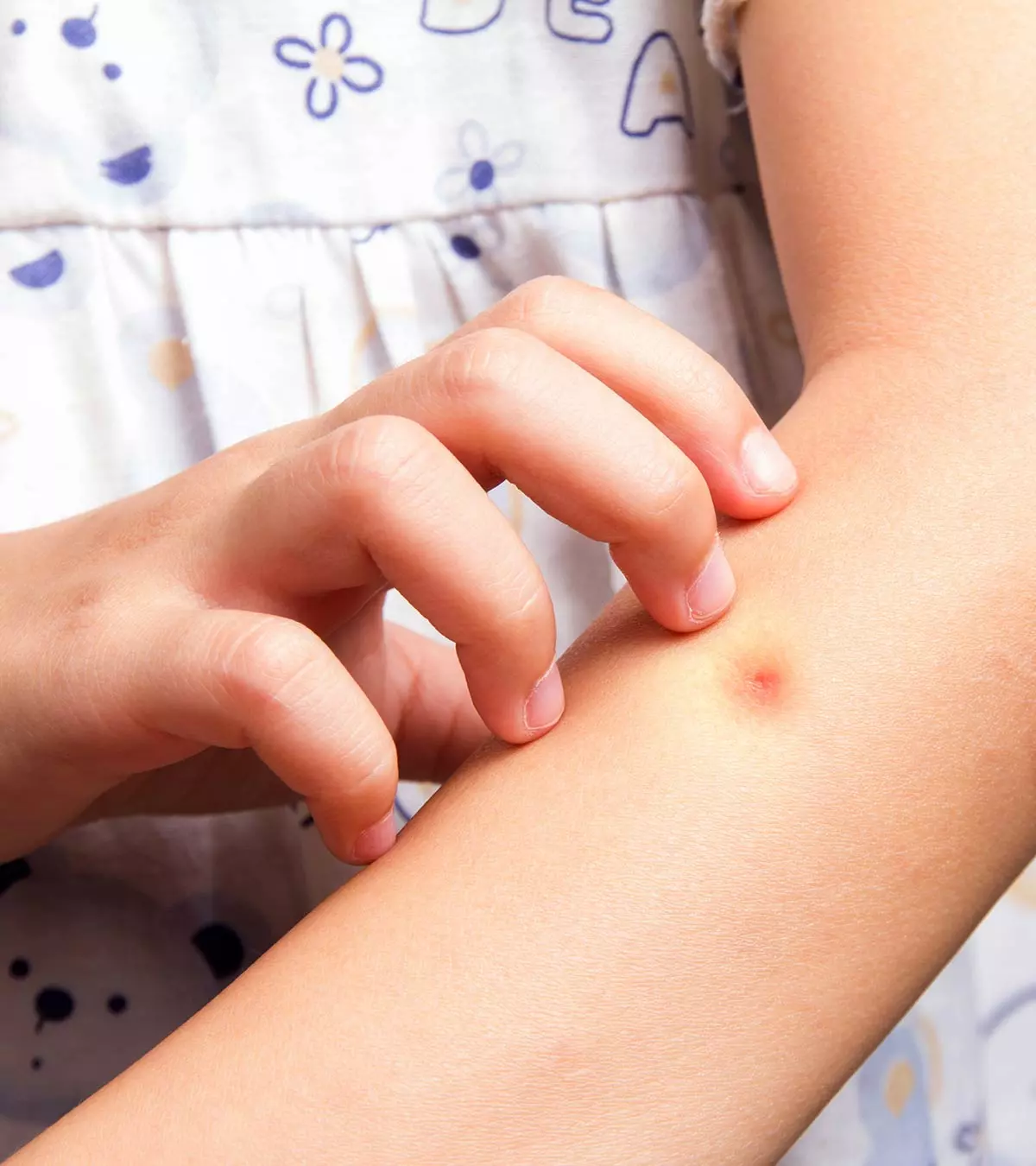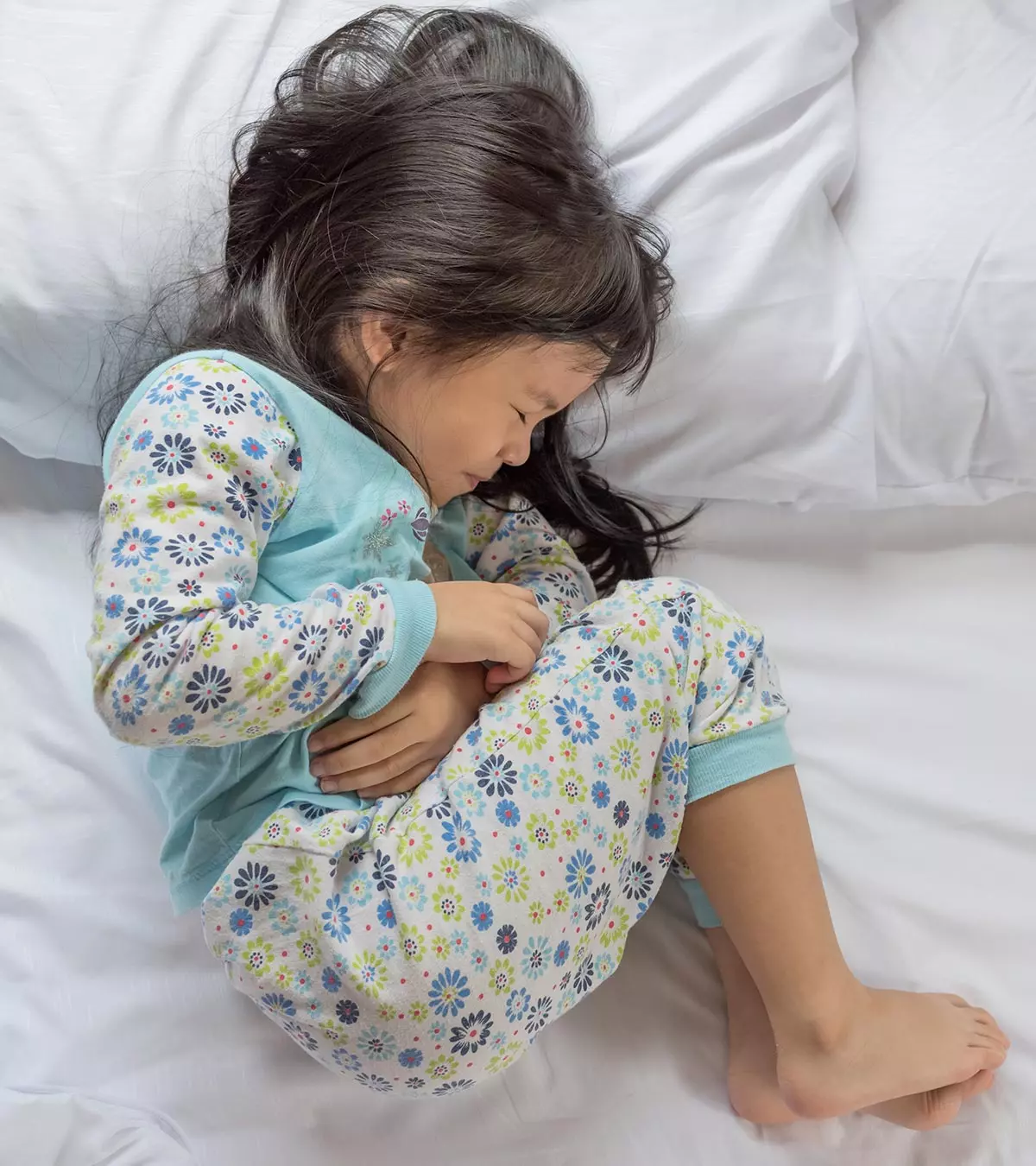
Image: Shutterstock
Alterations in normal vaginal microbiome or infections may cause vaginitis in children. It causes inflammation of the vagina and may result in pain, itching, and discharge. In addition, some children may have vulvovaginitis, where the vulvar area is inflamed with the vagina. It is a common condition in prepubescent girls.
Sometimes, poor skills and knowledge about maintaining vaginal hygiene and wiping in the wrong direction after bowel movements can cause vaginitis in younger girls. Thus, teaching personal hygiene measures, including vaginal hygiene, may help prevent vaginitis in girls.
Read on to know the types, risk factors, causes, symptoms, treatment, and prevention of vaginitis in children.
Key Pointers
- Children may experience bacterial, fungal, or parasitic vulvovaginitis.
- Perfumed soaps, tissue papers, scented detergents, hormonal changes, STDs, etc., are a few causes of vaginitis in children.
- Vulvovaginitis may be characterized by itching, irritation, pain during urination, redness, light spotting, etc.
Types Of Vaginitis In Children

Image: Shutterstock
Vaginitis can be of the following types.
- Bacterial vaginosis happens due to changes in the normal vaginal bacteria and overgrowth of other bacteria in the vagina.
- Yeast/fungal infections are usually caused by the fungus Candida albicans.
- Trichomoniasis is a sexually transmitted parasitic infection usually seen in teenagers.
- Noninfectious vaginitis refers to vaginal irritation that happens without infection. It can happen because of an allergic reaction or due to irritation from using douches or hygiene products like vaginal sprays. Other products that can cause non-infectious vaginitis include perfumed soaps, detergents, and fabric conditioners (1). Some common symptoms of non-infectious vaginitis are vaginal burning, itching, and pelvic pain, particularly during sex. Since these symptoms may also indicate other conditions, taking advice from your healthcare provider is advisable.
You may consult a pediatric or gynecological health expert since the treatment may vary depending on the type of vaginitis.
Causes Of Vaginitis In Children
The causes may vary depending on the type of vaginitis. The following risk factors may disturb the balance of vaginal microbes, thus increasing the risk of vaginitis (1).
- Perfumed soaps
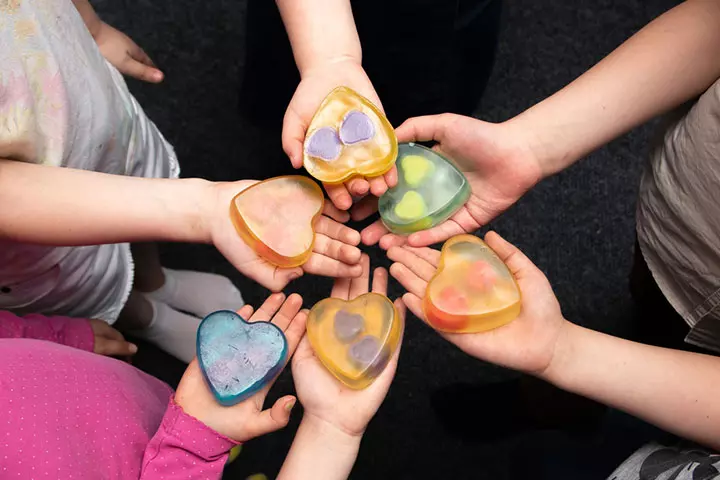
Image: Shutterstock
- Scented detergents
- Tissue paper
- Medications, such as steroids and antibiotics
- Damp or tight clothing
- Diabetes
- Hormonal changes
- Poor nutrition
- Weakened immune system
- Smoking
- Sexually active
Sexual abuse could also be a reason for vaginitis. However, girls without any sexual activity can also develop vaginitis. Speak to your child to ascertain the exact cause before jumping to conclusions.
 Quick fact
Quick factSymptoms And Signs Of Vaginitis In Children
Several signs and symptoms of vaginitis feel the same as urinary tract infection.
The following signs and symptoms are usually seen in vaginitis (2).
- Vaginal irritation
- Itching
- Pain during urination
- Vaginal discharge often with changes in its color and amount
- Vaginal spotting or light bleeding
- Redness or soreness
- Swelling
- Burning sensation

Image: Shutterstock
- A fishy smell from the affected area
Color and amount of vaginal discharge may indicate the type of vaginitis. You may notice the following characteristics of vaginal discharge.
- Bacterial vaginosis causes greyish-white discharge with a foul-smelling or fishy odor.
- Yeast infection causes thick white discharge resembling cottage cheese accompanied by severe itchiness.
- Trichomoniasis causes a greenish-yellow discharge that can often be frothy.
Parents need to recognize the signs early to prevent complications. Consult a pediatrician if your daughter has any of the symptoms and signs of vaginitis. Pelvic pain, fever, and chills, along with vaginitis, may require immediate medical care.
 Quick fact
Quick factComplications Of Vaginitis In Children
Untreated vaginitis may not be cured completely, and children may have itching and pain for a longer time. Injuries in the genital area due to repeated scratching and itching could increase the risk of secondary bacterial infections.
The child could have an increased risk of reinfections if a current infection is not adequately managed and treated. They may also have a higher risk of contracting sexually transmitted infections (STIs) and develop pregnancy-related complications, such as low birth weight babies and premature birth, later in life. Increases the risk of pelvic inflammatory disease (PID) and may lessen the success of fertility treatment as IVF.
Prevention Of Vaginitis In Children
Teaching good personal hygiene practices could help reduce the risk of vaginitis and its recurrence. Teenagers should receive sexual education to know about sexually transmitted infections and their prevention methods. You may also discuss with your daughter about hygiene practices during menstruation.
The following tips may help to avoid vaginitis.
- Wipe from front to back after using the toilet to prevent moving bacteria from the anal area to the vagina
- Clear soap from the outer vaginal area after a shower and always pat dry the area.
- Try loose-fitting and breathable undergarments instead of tight-fitting, synthetic underwear
- Always use clean and dry cloths
- Avoid hot tubs and bubble baths
- Avoid swimming or using whirlpool spas
- Do not use scented tampons or pads
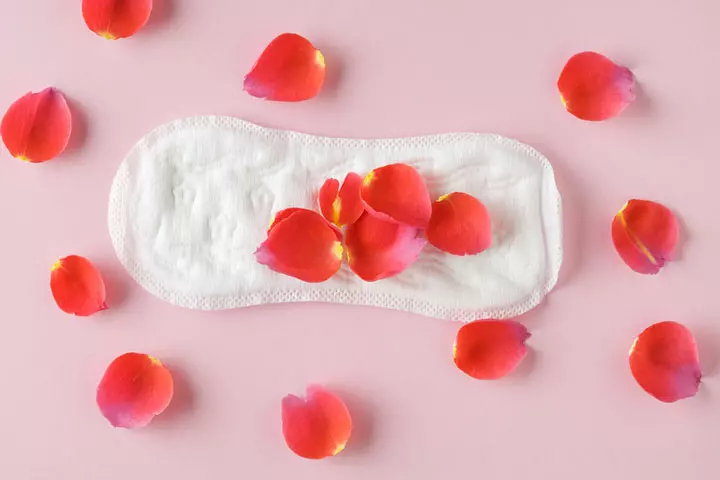
Image: Shutterstock
- Do not use harsh or scented soaps to wash the vagina
- Avoid vaginal sprays and deodorants
- Avoid douching as a method of cleansing the vagina.
Changes in estrogen and progesterone levels throughout the menstrual cycle can also affect vaginal health. Hence, proper knowledge about vaginal hygiene measures, especially once a child reaches puberty and starts menstruation, could help avoid vaginitis due to improper hygiene practices.
Diagnosis Of Vaginitis In Children
Pediatricians may review medical history and perform a pelvic exam to identify the type of vaginitis. Cervical or vaginal discharge samples are often collected for laboratory analysis. pH testing may help identify bacterial vaginosis or trichomoniasis since it may cause elevated pH levels (3).
Young girls may develop vaginitis due to sexual activity. Doctors may speak to the child and perform a further examination in cases of suspected sexual abuse, especially if young children are presented with vaginitis.
Treatment Of Vaginitis In Children
Vaginitis treatment can be specific based on the type and cause. These may include (3):
- Oral or topical antibiotics are prescribed in cases of bacterial vaginosis. An oral dose of Flagyl (metronidazole) tablets and topical Cleocin (clindamycin) cream, or Metrogel (metronidazole) gel is commonly used.

Image: Shutterstock
- Suppository or over-the-counter antifungal creams, such as Vagistat-1 (tioconazole), Monistat-1 (miconazole), or oral Diflucan (fluconazole), are used for the treatment of yeast infections in children.
- Tindamax (tinidazole) or Flagyl (metronidazole) tablets are prescribed for trichomoniasis.
These medications are prescribed after the confirmation of the diagnosis. You may seek expert help for the exact dosage and duration of treatment. Non-infectious vaginitis is usually treated by avoiding probable risk factors, such as new soap, sprays, or tampons.
Frequently Asked Questions
1. Can a little girl get vaginitis?
Yes, even girls as young as three to four (toddlers) can get vaginitis. This could be because they lack pubic hair and folded skin around the vaginal opening, which will protect the vulva from possible irritations and infectious agents (4).
2. Can vulvovaginitis go away on its own?
Mild vulvovaginitis might resolve without treatment. However, you must avoid the possible triggers (irritants and tight underclothes) in children. You should also get your child evaluated if they report any pain, fever, or vaginal discomfort (5).
3. How long do vaginitis symptoms last in children?
In some situations, the symptoms may resolve in a few days to a week with adequate treatment. However, chronic or recurring occurrences might require additional medical evaluation and management (8).
4. Is there any research on vaginitis in children?
Yes, there has been research on vaginitis in children. Studies have concentrated on causes, risk factors, treatment choices, and long-term results to enhance understanding and management of this condition (9) (10).
5. Is there a risk of infertility if a child has vaginitis?
Vaginitis does not pose a direct risk of infertility in either children or adults. However, if left untreated or its underlying cause goes unaddressed, it could lead to complications that may impact fertility later in life.
Pain, irritation, and discharge in the vaginal area could indicate vaginal inflammation or vaginitis in children. It is usually caused by alterations in the microbial balance of the vagina. Timely diagnosis and treatment are vital for preventing long-term consequences. Hence, consult a healthcare provider if your child experiences any signs of vaginitis to avoid the risk of complications and reinfections. Further, you can reduce the risk of vaginitis in children by ensuring they maintain good personal hygiene and educating them about safety measures.
Infographic: Ways To Prevent Vaginitis In Children
Vaginitis is a microbial infection that may be prevented by maintaining proper hygiene. The vagina is a self-cleaning body part, and washing it with soap or other cleansers may cause drying and alteration of its pH resulting in increased microbial growth. The infographic below highlights ways to prevent vaginitis in children.
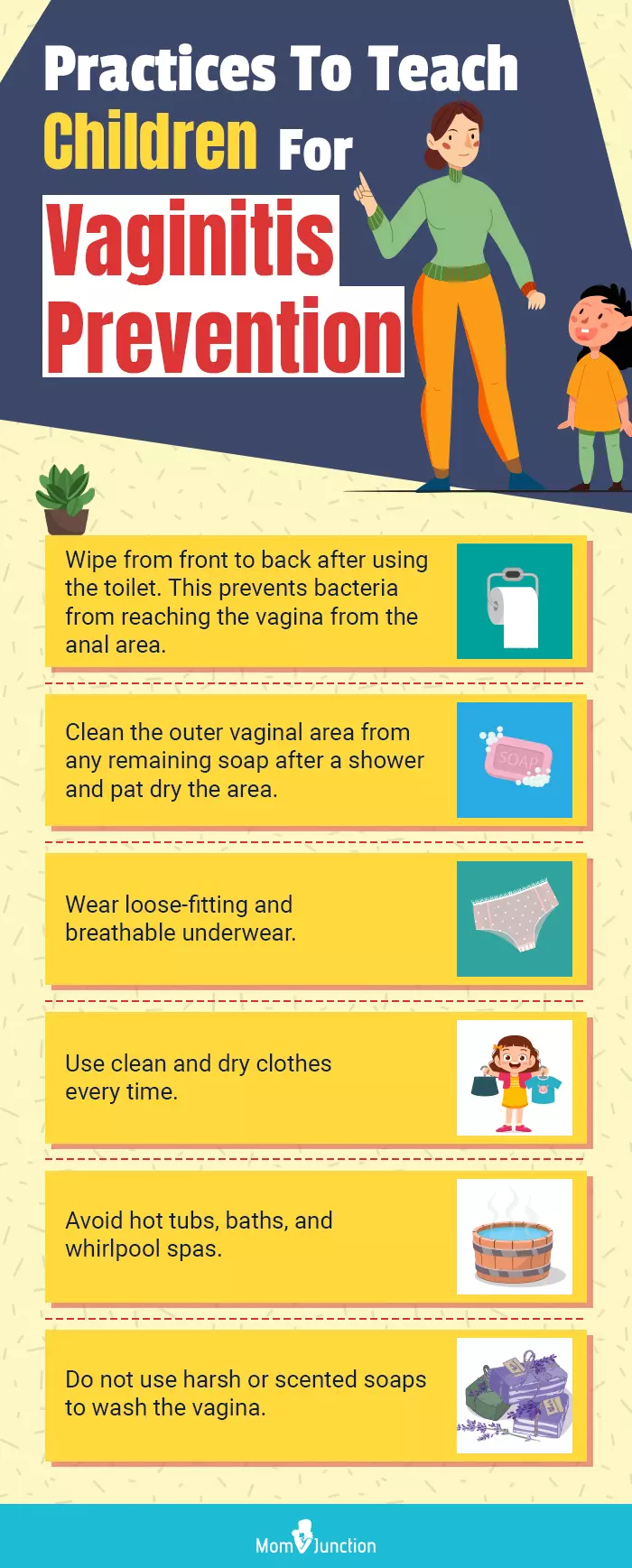
Illustration: Momjunction Design Team
Illustration: Vaginitis In Children: Causes Symptoms And Ways To Treat It

Image: Dall·E/MomJunction Design Team
This video provides valuable information about the causes, treatments, and tips for dealing with vaginitis. Learn the facts on this common condition and how to manage it.
References
- Vaginitis; John Hopkins Medicine
https://www.hopkinsmedicine.org/health/conditions-and-diseases/vaginitis - Vaginitis; Planned Parenthood
https://www.plannedparenthood.org/learn/health-and-wellness/vaginitis - Vaginitis: Diagnosis and Treatment; The American Academy of Family Physicians
https://www.aafp.org/pubs/afp/issues/2011/0401/p807.html - Vulvovaginitis Toddler; Cleveland Clinic.
https://my.clevelandclinic.org/health/diseases/22488-vulvovaginitis-toddler#:~:text=Vulvovaginitis%20in%20toddlers%2C%20or%20pediatric - Vulvovaginitis; The Royal Children’s Hospital Melbourne.
https://www.rch.org.au/kidsinfo/fact_sheets/Vulvovaginitis/#:~:text=Mild%20vulvovaginitis%20is%20a%20very%20common%20problem. - Vulvovaginitis; University of Colorado School of Medicine
https://www.childrenscolorado.org/conditions-and-advice/conditions-and-symptoms/conditions/pediatric-vulvovaginitis/ - Pediatric Vulvovaginitis; Children’s Hospital Association
https://www.childrens.com/specialties-services/conditions/vulvovaginitis - GYNECOLOGY Vulvovaginitis; Children’s Hospital Colorado
https://www.childrenscolorado.org/conditions-and-advice/conditions-and-symptoms/conditions/pediatric-vulvovaginitis/ - Do we need to treat vulvovaginitis in prepubertal girls?; National Library of Medicine
https://www.ncbi.nlm.nih.gov/pmc/articles/PMC544997/ - Prepubertal vulvovaginitis; National Library of Medicine
https://www.ncbi.nlm.nih.gov/pmc/articles/PMC6028267/
Community Experiences
Join the conversation and become a part of our nurturing community! Share your stories, experiences, and insights to connect with fellow parents.
Read full bio of Dr. Rana Chanchal
Read full bio of Dr Bisny T. Joseph
Read full bio of Dr. Ritika Shah
Read full bio of Shinta Liz Sunny













